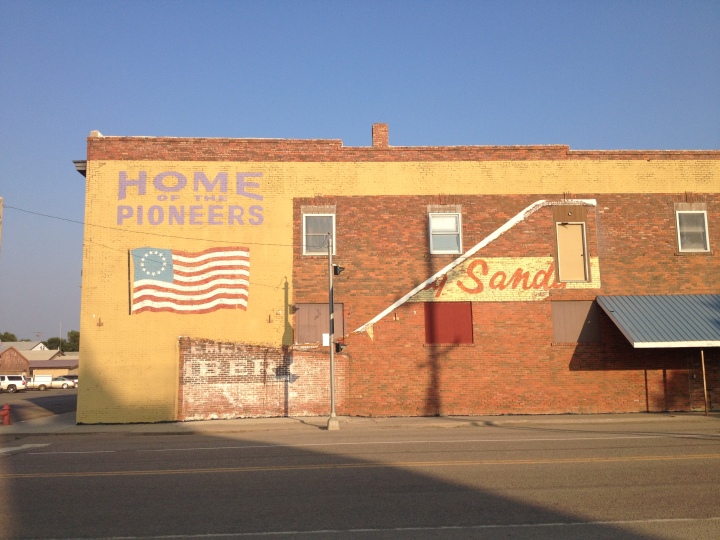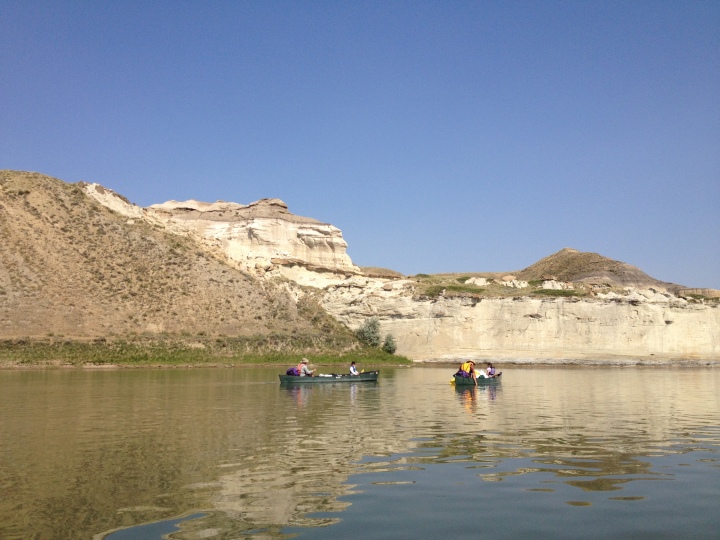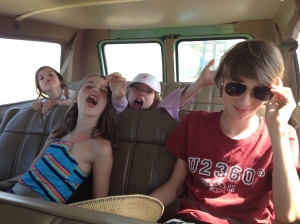
An old bath tub in Sun River, Montana, en route to the Missouri Breaks National Monument where our canoe trip would begin.
Reflections and Ripples
Slow, pretty
Moves, sparkles,
Meanders,
Mirror image and pattern—
Amazement.
Written by E (aged 8 ¼) in Great Falls after our return
from paddling the Upper Missouri River, July 7, 2015.

Big Sandy, Montana, home of John Tester (the US senator representing Montana). We stopped here en route to Chinook where we spent a night with MB and FB before hitting Havre and Fort Benton.
I couldn’t think of how to start this entry, so I borrowed a poem E had written the day after our return from canoeing 46.5 miles from Coal Banks to Judith Landing on the Upper Missouri River. Meriwether Lewis and William Clark covered the same ground on their epic 1805 search for the Northwest Passage—only they went against the current while we chose the easier option of going with it. In the moments when the wind was against us, which was not often, I marvelled at how these explorers could have not only gone against the current but done so with the wind in their faces.

The road from Chinook to Havre, en route to Fort Benton where we would spend our final night before hitting the Missouri River.
Our friend MB had brought the Lewis and Clark diaries and when we were able to snatch a moment from our making and breaking camp, our cooking, our schlepping of tents, sleeping bags, cooking equipment and food to and from the boats, and from the hours of canoeing and kayaking we had to put in each day, we sat and listened while MB read from their journals. Her favourite part, which she liked so much, she had to reread a couple of times was the following written 220 years ago on the same stretch of river, where Lewis described the bluffs he and Clark saw as being “a thousand grotesque figures… lofty freestone buildings … the parapets well stocked with statuary … so perfect indeed are those walls that I should have thought that nature had attempted here to rival the human art of masonry had I not recollected that she had first begun her work.” She had indeed begun her work long before humans had even dreamed of this canyon.

A subtle bar sign in Havre, Montana. (Note: the images are out of sync with the words here because for most of the trip, we were all too busy paddling or setting up camp or cooking to take photos. And as it rained much of the time cameras and phones were packed away to stay dry.)
The cliffs made of Virgelle sandstone are so soft that wind and rain and snow and hail continue to carve them. The forces of nature are such that the rocks take on recognisable shapes. Like inkblots, you can see what you want in them: faces, cities, hands, saints, birds, hieroglyphs and pyramids, men and women exchanging secrets. We saw everything in those rocks. Canoeing below these formations one feels terribly small. Our party consisted of J and myself, along with MB and another wonderful friend KB, who was also (thankfully) an experienced sea kayaking guide. Between us we had four children, three canoes and one kayak. The sensation on the water is one of total remoteness. There is no road access, there is no going back or calling for help. You are alone and unreachable, and for the kids with us who ranged from 8 to 12 years of age, this must have seemed completely foreign: no devices, no stopping for ice-cream, no returning for a pair of forgotten shoes, nothing but your own strength and ingenuity and seeking fun from the activities that are moving you forward to your destination. And you do need to keep going forward. There is no way off the river apart from the landings that appear every 50 miles or so.

Loading up the canoes at Coal Banks, the start of our trip.
Our first day of paddling went well and when we stopped for lunch, the kids managed to get in a couple of hours of mucking about in the river to cool off while we discussed our itinerary. The temperatures were in the mid-nineties and the water, which was as warm as a bath, was only slightly cooler than the air. In the afternoon we made it to our first campsite at Eagle Creek. The night was beautiful, but around 10:30 p.m., it began to rain, ever so lightly. We said our goodnights and headed to our respective sleeping bags. I was finding it hard to sleep even after a long hot day of paddling. The rain was getting harder and the air was becoming electric. You could hear the limbs of the nearby cottonwoods whooshing above. Just before midnight the lightning started, then the thunder, then the driving winds. J and I couldn’t sleep. We watched the inside of our tent turn white, then purple, then red with each flash of lightning, like fluorescent rainbow lights being turned on and off. I watched E with fascination as she somehow managed to sleep through the thunder and rain and hail which had begun to lash our tent.

The kids playing in the river while we loaded the canoes.
About an hour or two into the storm, we heard something that sounded like a jet taking off. We waited for whatever it was to hit, hoping our tent would hold. But it seemed to pass above us. In my imagination it was a black, cartoon cloud being puffed across the sky by a Loony Tune Zephyr. The hail continued as did the lightning and thunder. I longed to go outside and see the canyon walls light up with colour, but I was too terrified to move. And I thought it best to stay on my rubber mat rather than expose myself to lightning. Just as the storm seemed to subside and it looked as if sleep might be possible, another one started. For several more hours we lay and watched the flashes of light and listened to the howling. Neither J nor I said much. This was the fourth of July and we had got our fireworks.

Sandstone formations along the river during a rare break from paddling.
I think we managed a few hours of sleep in the early morning and woke to a grey day. It was as if the storm had been a dream. We exchanged stories with MB and KB, and it turned out we had all experienced the same terrifying night but with subtle variations. MB had gone down to the river before we all took to our tents and had shared the bank with a beaver. They eyed each other before he slapped his tail on the sand and escaped to his lodge across the water. Just after this, she felt a strange fizzing coming along the river and saw lightning approaching along the horizon. She could sense something in the air, something reminiscent of the winds she had experienced growing up in Wyoming and on the prairies and went to her tent where her daughter Amelia was sleeping. KB, on the other hand, had spent the night in the outhouse with his two children. His 8-year-old daughter experiences vivid nightmares and has a fear of lightning. So, for him waiting out the storm meant a night of sitting in a camp chair reading the laminated posters about noxious weeds on the inside of the pit toilet for five hours.

Some intrepid climbing by master paddler Elias, aged 12.
I worried that E might be upset to have been the only one of our party of eight to have missed this huge elemental event, but she seemed fine about it. And she was the only one of us who was remotely well rested the following day. Despite the continuing rain, we needed to press on. By the early afternoon, the constant rain had soaked us all through. Two of the kids were shivering uncontrollably and I noticed E’s lips were turning white. We got our boats together and had a meeting on the river about what to do. Should we pull over and warm up or hope the kids could make it another couple of hours to the next campground. While we were discussing, a flash of lightning appeared. Problem solved: we had to get off the water fast.

Two of the four boats in our party with some of the famous White Cliffs in the background
We pulled over at the first place we could, which happened to be a wash. And it was raining. And I think we all thought “Oh, man, a muddy wash in the pouring rain. Great idea!” But we had no choice. We had to get off the water and get the children warm. We trudged up from the bank, to get away from the bottom of the cliffs where the mouth of the clay-bottomed wash opened to the river, and found a patch of fairly flat ground. KB and his 12-year-old son erected a tent with super-human speed and we stripped the kids down and stuck them in sleeping bags to warm up. Meanwhile the four adults managed to dredge out some slightly drier clothing, which seemed pointless as it was only going to get wet again, but it felt very good. KB and MB magically produced some micro-fiber towels that absorb crazy amounts of water. While we discussed our next move, we could hear laughter and singing from the tent where the four children were holed up. They had gone from teary and shivery to bouncy jumping jacks in a matter of minutes.

Our campsite at Eagle Creek just before the storm flew in.
The wash was beginning to fill with water and our boats would begin to float away, so we packed up, got into our canoes and headed to our next campsite which was about five miles away or about an hour of serious paddling. When we got to the campsite at Slaughter River, it stopped raining but we were all still shivering. As if by some divine hand, there was a shelter at this campsite and within this shelter was dry wood. Dry wood! The knowledge that there would be heat ignited something so deep and primal in me. The children warmed themselves and we set up camp and ate a pasta that our hunger had rendered ridiculously delicious and then we made s’mores. “This is what camping is all about,” I was thinking. But the Norman Rockwell image faded quickly as more rain began to fall. We headed to our tents exhausted from the previous night of very little sleep and a rain-soaked, twenty-mile paddle that very day.
As the following morning was warm and sunny, we luxuriated in the heat and power of the sun and pegged up as many of our belongings and items of clothing as possible to dry them before packing up and getting back in the boats for the final 12-mile leg of the trip. The river was still and calm. The swifts and swallows were out and flew so close, we could hear the beating of their tiny wings. They were looking for bugs on the river’s glassy surface.

The magical huts where we found firewood. This is the sun rising on our final morning as MB and J made coffee and did the washing up from the night before.
We had arranged to meet Mike of Missouri River Outfitters, from whom we had rented our canoes, at 2 pm. He was to pick us and the canoes up and drive us back to our cars, which were parked at Coal Banks. We were an hour late and after apologising and telling him we had had a few set-backs he told us not to worry. Apparently we had been three miles from a tornado. It had overturned railway cars and shut down the power in nearby Havre (a town around 60 miles from us) for 24 hours and had generally caused mayhem. Hail the size of golf balls had been reported. I looked at K and M and J as the news sank in. Three miles from a tornado. That was the sound we had all heard. The jet taking off, was probably a huge swirling mass of wind sucking in whatever it could as it passed above us. In Mike’s van on the way to our cars, we felt a communal sense of relief, gratitude and awe. The ‘what ifs’ began to surface. What if we had camped in another site? What if the wind had shifted and our boats had been sucked downriver, or worse, our tents? Or us? Or our kids? What if trees had been uprooted and had come crashing down? The what ifs for me became one endless riff in my head.
And then they stopped.
I accepted that we had come close to something that could have gone very wrong, but it hadn’t. We were fine, we were elated, we were tired and dirty and had been together through it all, a group of friends entrusting our well-being and that of our children to each other. At every step of our journey we encountered some tense moments requiring quick decisions and yet just before things got serious, some unexpected twist of fate would intervene with a pile of fire wood, with a wash that didn’t give us a flash flood, with a tornado that passed overhead, with rain that held off until our tents were up and our sleeping bags inside. It is difficult when you are so reliant on the elements not to ascribe motives to them: either benign or aggressive. In our case, it felt as if some strange elemental force was watching over us, reflecting our smallness back at us while at the same time, constantly providing us with an escape. I could almost feel a hand leading us to safety with every stroke of my paddle.

The four kids in the van heading to our cars and to a night in a room with real beds and four walls. Happy to have survived the hard work and the storm.
In preparation to moving to Montana, I had read some John Muir (My First Summer in the Sierra, 1911 and A Thousand-Mile Walk to the Gulf, 1916), Henry David Thoreau (Walden, 1854) and Ralph Waldo Emerson (Nature, 1836) as a first step in trying to understand the American relationship to wilderness. Much as I loved these books and felt they offered a way in to the wild Montana landscapes, really the only way in is to simply immerse yourself. Emerson writes, “Nature is a language and every new fact one learns is a new word; but it is not a language taken to pieces and dead in the dictionary, but the language put together into a most significant and universal sense. I wish to learn this language—not that I may know a new grammar, but that I may read the great book which is written in that tongue.”
Canoeing the Upper Missouri river is just that: Reading a great book written in the language of the river itself.



